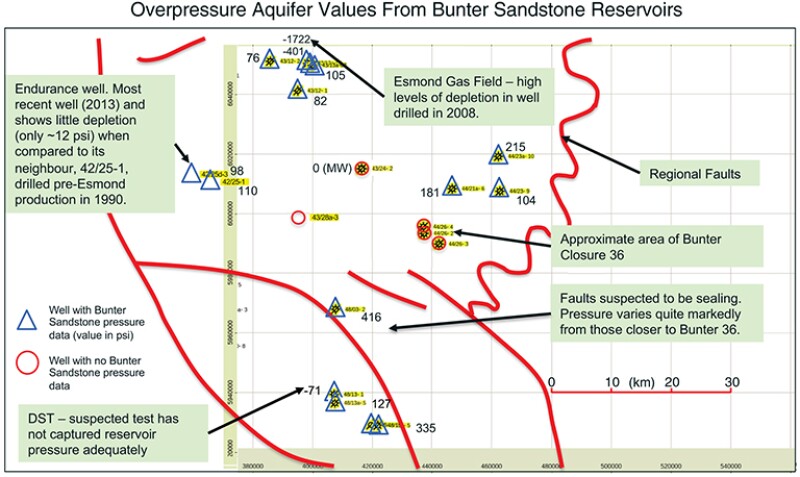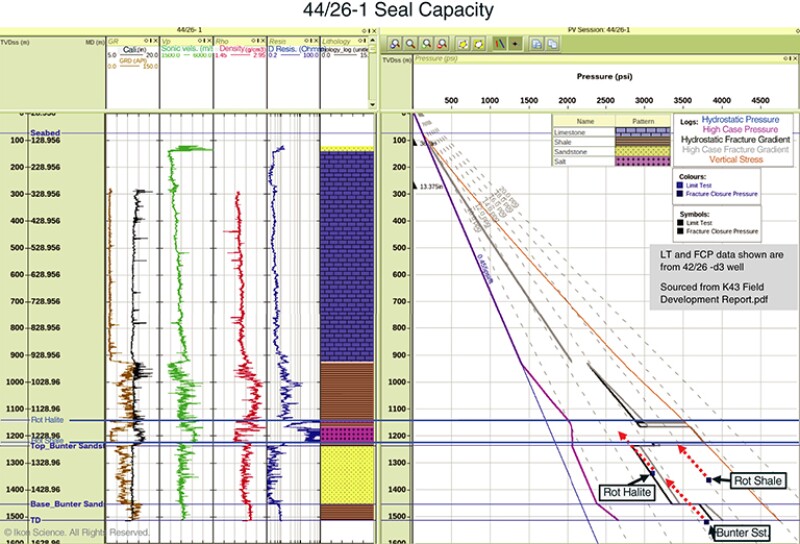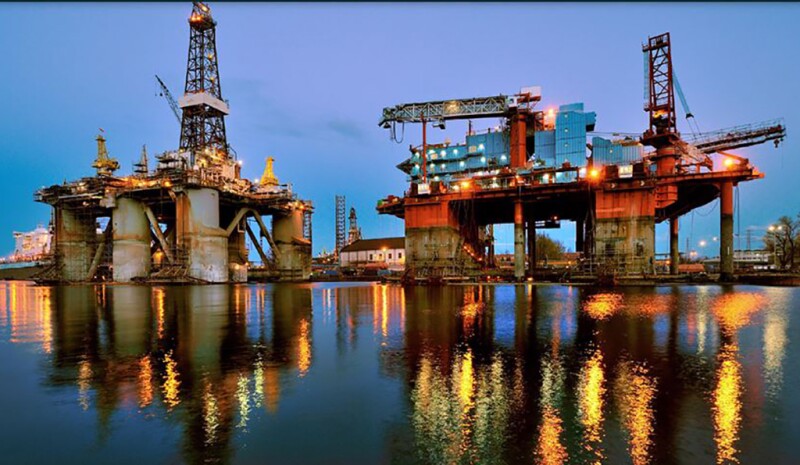To ensure success in exploration and production activities, oil and gas companies rely on subsurface data to gain insights that guide operational decisions over the life of their wells. But as wells near the end of their lives and production slows or stops, wells are subsequently shut and abandoned, and the accompanying subsurface data are set aside. However, these data still hold tremendous value when it comes to evaluating mature, near-end-of-life wells and fields to determine if they are suitable candidates for carbon capture, utilization, and storage (CCUS). Reusing wells and fields for CO2 injection provides an opportunity to reduce the time and cost for developing new CCUS infrastructure required by energy mix diversification efforts while avoiding the steep expenses commonly associated with decommissioning.
In most cases, when the production cycle ends and all usable hydrocarbons have been extracted, the topside facilities are dismantled, the wellbore is permanently plugged and abandoned, and the surrounding land or seabed is returned to its natural condition. Historically, this complex, multistep process has been a cost center for oil and gas businesses, requiring monumental investment that grows even higher for offshore and deepwater fields.
However, now that the CCUS industry is aggressively expanding, operators are presented with the possibility of turning decommissioned wells into a profit center by selling CO2 storage capacity to others. CO2 storage is a crucial component of the CCUS value chain as permanently storing CO2 is the cornerstone of large-scale emissions reductions. The storage process entails capturing, compressing, and injecting CO2 into a reservoir of porous rock beneath an impermeable layer of caprock, which functions as a seal. The caprock prevents the CO2 from reaching the surface, as do other trapping mechanisms including structural, residual, solubility, and mineral trapping. As a result, CO2 is safely stored in geological formations. This is similar to the unexplored state of oil and gas reserves trapped underground for millions of years.
Carbon-storage processes are not a new concept in the oil and gas industry. As part of normal well operations, operators routinely perform the CO2 injection enhanced oil recovery (EOR) technique. If CO2 returns to the surface and is separated and then reinjected to form a closed loop when utilizing this EOR method, this results in permanent CO2 storage, which strongly supports the viability for repurposing mature decommissioned wells.
In response to growing interest in CCUS and governments worldwide committing to reach a net-zero target for CO2 emissions in the coming decades, a consortium of 20 organizations including research institutions, operators, and regulatory authorities joined together to create REX-CO2 (ReUsing Existing Wells for CO2 Capture and Storage). As part of the REX-CO2 consortium, Ikon Science collaborated with the British Geological Survey (BGS) in the phases of a study that evaluated the potential for well reuse in the UK Continental Shelf (UKCS). It’s forecast that 1,211 wells across 230 fields will be decommissioned through 2028 in the UKCS to the tune of $60 billion, according to Britain’s Oil & Gas Authority’s 2021 Decommissioning Cost Estimate report.
The well reuse investigation work focused on two case study areas: the saline aquifer of Bunter Closure 36 in the Southern North Sea Basin and the Hamilton depleted gas field in the East Irish Sea Basin. Bunter Closure 36 is a large dome‑like structure which was targeted by an exploration well in the 1960s; however, the reservoir was abandoned (most likely due to being dry or water-wet). In the 1980s, an exploration well was again drilled through Bunter Closure 36, this time targeting a reservoir in the much deeper carboniferous-aged coal measures. This later well led to the discovery of the Schooner gas field, and over the decades that followed numerous production wells were drilled through Bunter Closure 36 to produce gas from this deeper target. As a result, a high number of well penetrations passed through Bunter Closure 36 and will be due for decommissioning in the coming years.
For the study, Ikon employed the software program RokDoc to analyze a selection of regional wells as well as those that drilled through Bunter Closure 36 to accurately evaluate the subsurface and verify the suitability of those wells for both reuse and CO2 injection and storage. As the wells in the immediate vicinity of the Bunter Closure 36 case study lacked comprehensive pressure data measurements such as repeat formation tester and modular formation dynamics tester due to the targeting of deeper carboniferous-aged reservoirs, Ikon’s Southern North Sea Well Database was used to examine regional wells within the same reservoir and fault block (Fig. 1) to fill in missing data.

This regional study enabled the team to determine that the depletion effects from producing fields, such as the Esmond gas field, were minimal (Fig. 2) and that present-day pressure was likely to be near hydrostatic, or potentially overpressured, to around 200 psi. The data showed the reservoir was connected and demonstrated good porosity and permeability over a long distance (Fig. 2). The results of these initial investigations on two key parameters that indicate the geological suitability of the field for CO2 injection—reservoir pressure and seal-fracture strength—allowed Ikon and BGS to calculate and confirm the presence of sufficient vertical effective stress within the reservoir for safe CO2 containment (Fig. 3).


In addition to reservoir pressure and seal-fracture strength, the type of casing and cement used to design and complete the wells had a strong impact on a well’s reuse potential. Grades of steel that are more susceptible to corrosion and certain types of cement may reduce a well’s potential to be repurposed for CO2 storage. Additionally, the number of casing strings present through a formation may require operators to perform extensive downhole operations such as sidetracking, cutting and removing existing casing strings, milling casing and cement, and/or perforating with large charge sizes in order to access the reservoir. Such activities could render a well economically impractical for reuse.
If a well has been deemed viable for repurposing, the specific type of reuse must be considered. Generally, there are three ways to repurpose a well during a CO2 storage operation: water extraction during CO2 injection for pressure management, monitoring of CO2 plume, or CO2 injection. Determining which of these purposes is most appropriate for a given well requires careful analysis of several factors. For example, a well that’s close to the spill point may not be the best option for CO2 injection because of the risk of the plume migrating beneath the spill point, though reusing the well for CO2 monitoring may be suitable. In addition, the location of the wells where CO2 is injected can impact CO2 migration. If the migration route is close to the crest, opportunities for residual and solubility trapping are limited. Ideally, the well will be located at a midpoint between the spill point and crest to allow CO2 to migrate towards the crest under buoyancy. Among the available reservoirs for carbon storage, deep saline formations and depleted oil and gas reservoirs offer the largest CO2 storage capacity.
The global push to reduce emissions to targeted levels in pursuit of a net-zero goal means that we can expect a growing number of oil and gas wells to be decommissioned in the coming years—and a growing number of operators to consider turning existing wells into a profit center by selling CO2 storage capacity to others. Correctly evaluating subsurface data allows us to accurately determine which wells are best suited for CO2 storage as well as which wells require rehabilitation to ensure durable long-term storage. When done successfully, offshore and onshore wells can be repurposed for carbon storage to reduce the astronomical costs of decommissioning while simultaneously moving the needle on global CCUS initiatives.
The presented work has been performed in the REX-CO2 project, which is funded through the ACT program (Accelerating CCS Technologies, Horizon2020 Project No. 299681). Financial contributions made from ADEME (FR); Ministry of Economic Affairs and Climate Policy (NL); Gassnova and RCN (NO); UEFISCDI (RO); BEIS, NERC, and EPSRC (UK); and US-DOE (USA) are gratefully acknowledged.

Ed Hoskin is a technical manager–Well, EA and ME at Ikon Science. He was Ikon’s team lead in its BGS collaboration. Hoskin’s career in oil and energy spans more than 14 years. He holds a master’s of earth sciences degree from University of Southampton.

